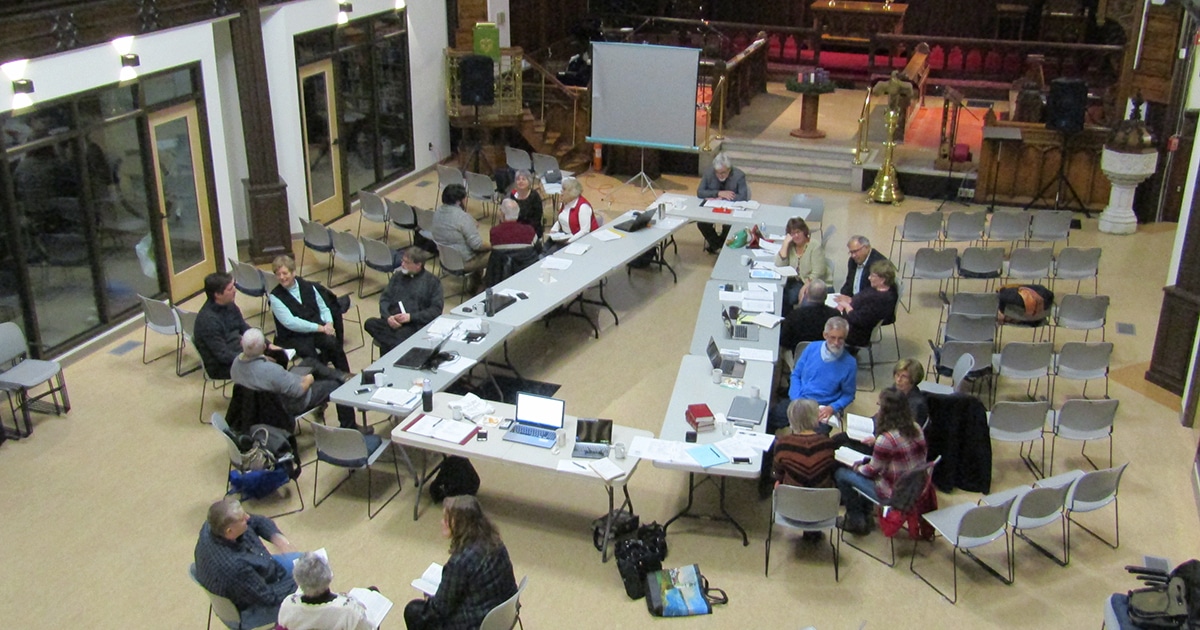Only a short time ago, St. John (Stone) Church in the Parish of St. Mark faced a situation familiar to many churches across Canada. With a historic church building too large for its present congregation but in need of repair, the parish found itself burdened by high maintenance costs, competing pressures for ministry, and a significant carbon footprint.
Now Stone Church—located in St. John, N.B. in the Diocese of Fredericton—has turned its weaknesses into strengths and a revitalized relationship with the local community. Over the course of 2016, the 191-year-old church underwent a major renovation marked by the demolition of the parish hall, the construction of six new rooms under a previously unused balcony, and flexible seating that replaced the pews.
“It’s kind of like that prayer at the end of the Eucharist—‘more than we can ask or imagine’,” rector John Paul Westin said. “We found that the thing that we thought was actually our main stumbling block became our greatest resource.
“The result of it [was that] instead of having a beautiful old church building that people who want to worship in can come and use for two hours a week, we now have something that’s accessible and used by people for seven days a week.”
Out with the old
At the time Westin took over as rector of Stone Church in August 2013, discussions had been going on for approximately a decade regarding the dilapidated state of the hall, which hosted community programs such as a laundry mission, language classes for immigrants, Bible study, and the Street Hope outreach program.
His predecessor David Edwards—now bishop of Fredericton—also took part in discussions over how to deal with the decaying infrastructure while serving as rector from 2002 to 2011.
“During my time it became clear that something needed to be done with the buildings,” Edwards said. “At that time we vaguely spoke about demolishing the hall and going into one space, but really the main thrust was the replacement or renovation of the hall.”
The cost of renovating the hall would have carried an estimated price tag of $2.2 million, while still leaving the old church building as it was. Though unable to afford to keep both buildings going, parishioners felt called to stay put and minister in their current location.
The obstacles facing the congregation appeared insurmountable—until a new idea came to the fore.
“We had never considered that the church and the hall would be one building,” Westin said.
“When we let go of our expectations of what our limitations were,” he added, “we started to see things from a different perspective.”
In with the new
By demolishing the hall and moving its functions into the church building, the congregation relieved itself of a significant financial and environmental burden while retaining the community programs that used the hall.
The six new rooms under the balcony accommodate a kitchen, office, Sunday school, and meeting rooms. Each has soundproof glass walls, through which anyone inside can still see the stained glass windows visible in the main part of the church.
Meanwhile, the church has undergone extensive renovations through the removal of pews and their replacement by flexible seating in the main part of the sanctuary. In the process, congregation members and guests were once again able to use its balcony, previously closed due to fire regulations.
Westin said that the revamped church has been “extremely well-received” by the congregation and the wider community, including other churches and the Heritage Conversation Service of St. John, which promotes the rehabilitation and development of historic buildings.
Strengthening community ties
Besides opening up new possibility for worship, such as incorporating Messy Church and creating different seating structures for different liturgical purposes, the new layout has helped Stone Church attract a variety of artists and community groups.
Recently, the church hosted a concert by Christian singer-songwriter Steve Bell, who played to a packed house that filled even the balcony seats, and many more concerts are planned in the future. It has also hosted a wide variety of community events, such as a conference for the healthy eating network Everyone Can Eat, and a seminar for Threshold Ministries.
Westin estimated that at least 10 different groups have already held activities in the church, which offers a sound system and completely open free space in which people can set up chairs and tables.
“I think groups are starting to see us, as we had hoped, as a possible venue, so that we can get more people from the community in and using it—so it’s not simply seen as a church worship space, but as a space that might be usable for various community groups.”
While the church still has to finish paying off some of the funds that helped finance the renovation, it remains in line with its projected financial plan. The cost of the new building is presently less than half that of maintaining the two older buildings.
On a deeper level, the reinvention of Stone Church has started a conversation among parishioners about how the structural changes will affect the future life of the congregation. For other churches considering similar renovations, Westin highlighted the need to answer such fundamental questions to better equip each congregation for its own distinct mission and ministry.
“Every building has its own strengths and weaknesses, so I would say just be really open to what God might be able to show you can be done with your building … Try to discern what are the needs of the community, and what are your strengths in your congregation, and what do you need your buildings to be able to be used for in order to accomplish the work that you feel God’s calling you to do in your community.”
Interested in keeping up-to-date on news, opinion, events and resources from the Anglican Church of Canada? Sign up for our email alerts .

